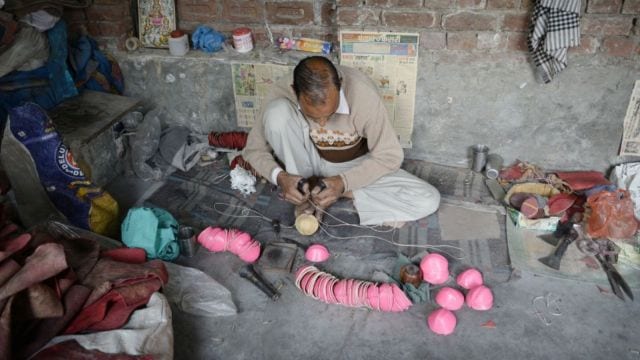Jalandhar West: once a hub of hide, leather industry, now forsaken
Hide sellers and people involved in the business of cleaning/treating hides say with declining business, their fate declined too, and “now, no one talks about our pain.”
 A worker makes leather cricket balls at the Bootan Mandi area under the Jalandhar West (Reserved) Assembly segment. Over the past few decades, the hides business declined sharply by 80-90 per cent. (Express photo)
A worker makes leather cricket balls at the Bootan Mandi area under the Jalandhar West (Reserved) Assembly segment. Over the past few decades, the hides business declined sharply by 80-90 per cent. (Express photo)Once bustling with the trade of hides sourced from across Punjab and neighbouring states like Rajasthan and Himachal Pradesh, the Bootan Mandi area of the Jalandhar West (Reserved) Assembly segment now looks forsaken with many hide sellers driven away by the emergence of alternative businesses such as carpentry and sanitary ware shops, marginalising the traditional hide market.
The entire Bootan Mandi road, once lined with hides and symbolising a thriving industry, now looks empty as a shadow of its former self. Hide sellers and people involved in the business of cleaning/treating hides say with declining business, their fate declined too, and “now, no one talks about our pain.”
“Till the 1990s, Bootan Mandi was renowned for its bustling hide business, where hides from various parts of the country would come for sale and distribution. However, with the turn of the century and changing conditions, once vibrant trade started dwindling significantly. Today, only less than 10 per cent of the hide business remains, a fraction of its glory,” remarked advocate Satpal Virdi, whose family was into this business, adding: “No political party is making any effort to revive it.”
“The dwindling hides trade had hit the local economy hard, rendering many jobless,” Virdi said. Over the past few decades, the hidesbusiness declined sharply by 80-90 per cent.
Raj Kumar, a small hide trader, attributed the declining business to “hyper activism cow vigilante groups”. “Despite supplying hides to Chennai and Kanpur, we have faced increasing harassment in recent years. Our trucks have been stopped by cow vigilante groups. Moreover, suppliers to Bootan Mandi from neighbouring states ceased operations due to harassment en route to the mandi. Gradually, this business started declining.”
Jeewan Kumar, another small trader in Bootan Mandi, pointed out, “Cow vigilante groups often misidentify even buffalo skin as cowhide. This misunderstanding has instilled fear among local suppliers from nearby villages, causing many to discontinue their visit to Bootan Mandi.”
“In Bootan Mandi, there used to be over 100 big, medium and small traders/sellers of hides, alongside those who came here from other parts of Punjab to sell hides a decade ago. However, from 2014 to 2016, there has been a drastic decline in their numbers, and now only 20 to 25 traders are in the field,” Virdi said. “Earlier, several trucks of hides used to come from Rajasthan, Himachal, Jammu, and even from villages in Punjab, but the volume has reduced considerably,” he noted.
“No political party has taken this matter seriously except for some lip services, letting this once thriving trade collapse completely,” said Raj Kumar. “Big traders had earned substantial profits during their heydays. They are now surviving by shifting to other businesses, but the situation remains dire for small traders,” he said.
Even tanneries located in the Jalandhar Leather Complex, though not part of this constituency, used to heavily rely on supplies of hides from these traders. The tannery industry was once a major economic pillar of Punjab, concentrated solely in Jalandhar. Before Covid-19, 59 out of the 61 tanneries were operational, but due to the pandemic and subsequent closure for 14 months due to environmental issues, only 30 to 35 are currently in operation.
“A decade ago, these tanneries used to produce 2.5 to 3 lakh square feet of leather daily. Now, they are operating at only 40 per cent of their capacity due to the closure of several units,” said Ajay Sharma, Secretary of the Punjab Leather Federation.
He highlighted sustainability concerns as a major reason for tannery closures, directly impacting the hide business and thousands of workers primarily from Bootan Mandi, Bhargav Camp, Abadpura, Model House, and surrounding areas falling under the Jalandhar West Constituency.
Sharma emphasised that government support, such as handholding measures, is crucial. “Our exports once used to be to the tune of around Rs. 2,000 crore annually,” he added.
“Even the Common Effluent Treatment Plant (CETP) with a capacity of 5 MLD set up to treat tannery effluents before discharging into the rainwater drain, is currently receiving only 2 MLD due to the closure of tanneries,” Sharma explained.
“In Jalandhar, an estimated 45 to 60 lakh square feet of hides were processed monthly for supply to other states and for use in the tanneries of Jalandhar Leather Complex. However, precise figures are currently unavailable to tanners or hide traders,” he continued.
Local leaders and businessmen like Harish Kumar and Pawan Kumar urged the government to implement supportive policies, noting that hide sellers and tanners are all discouraged and seeking alternative employment opportunities.












